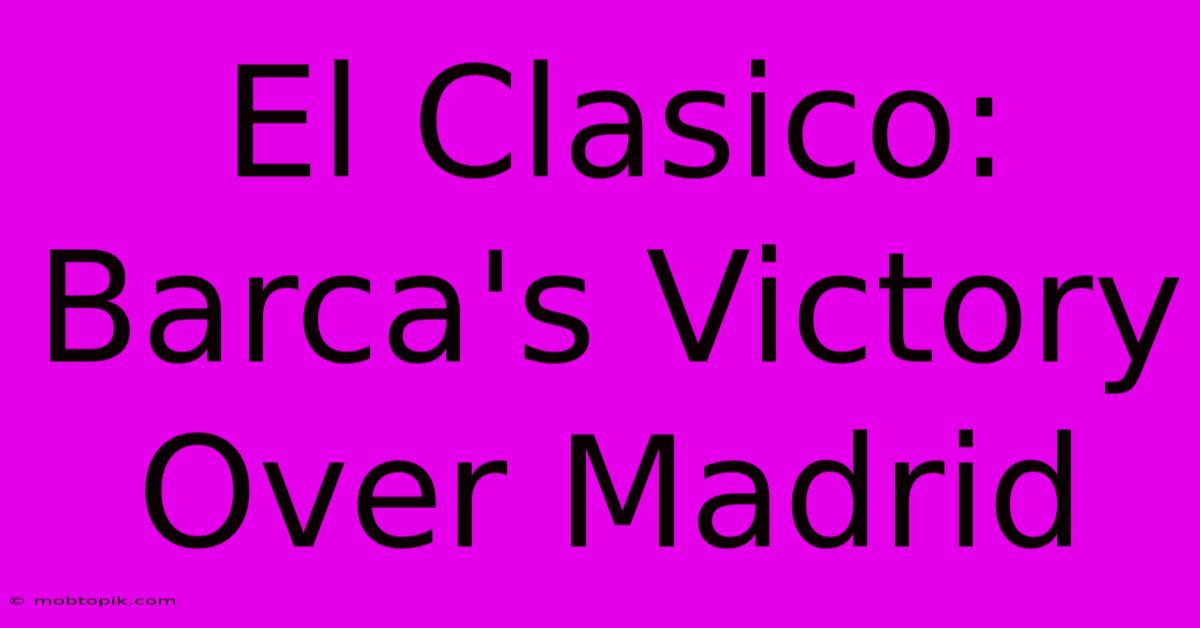El Clasico: Barca's Victory Over Madrid

Discover more detailed and exciting information on our website. Click the link below to start your adventure: Visit Best Website mobtopik.com. Don't miss out!
Table of Contents
El Clásico: Barcelona's Triumph Over Real Madrid – A Tactical Masterclass
El Clásico. The name itself evokes images of fervent passion, breathtaking skill, and dramatic twists. This legendary clash between FC Barcelona and Real Madrid is more than just a football match; it's a cultural phenomenon, a global spectacle watched by millions. And when one team emerges victorious, the echoes of that triumph reverberate throughout the footballing world for weeks, months, even years. This article delves deep into a recent Barcelona victory over Real Madrid, analyzing the tactical brilliance that paved the way to their success.
The Build-Up: A Clash of Titans
Before the whistle even blew, the atmosphere was electric. The stadium, a cauldron of roaring fans, was a testament to the immense weight of this fixture. Both teams arrived with contrasting styles and formations, adding another layer of anticipation to the already charged environment. Real Madrid, under [mention manager's name], were expected to employ their usual high-pressing, counter-attacking style, leveraging the pace and skill of their attacking players. Barcelona, under the guidance of [mention manager's name], were predicted to dominate possession, patiently probing for openings through intricate passing and fluid movement.
The Match: A Tactical Masterpiece
From the opening kickoff, Barcelona demonstrated their intent. Their midfield, orchestrated by [mention key midfielders, e.g., Pedri, Gavi, Busquets], controlled the tempo, dictating the rhythm of the game. Their passing was crisp and incisive, constantly shifting the point of attack and disrupting Madrid's defensive shape. Real Madrid’s high press, usually so effective, was neutralized by Barcelona's calm and precise passing, effectively bypassing the first line of pressure.
Barcelona's Dominance in Possession:
Barcelona's possession wasn't just for show; it was a strategic weapon. By maintaining such control, they limited Madrid's opportunities to launch counter-attacks, a key component of their game plan. The constant movement of Barcelona's attackers, creating triangles and interchanging positions, further disoriented the Madrid defense. This fluid movement, often described as "tiki-taka" evolved, made it incredibly difficult for Madrid to track runners and maintain defensive solidity.
Exploiting Madrid's Weaknesses:
Barcelona’s tactical acumen was evident in their ability to exploit specific weaknesses in Madrid's defensive setup. [Mention specific defensive weaknesses exploited by Barcelona, e.g., lack of pace at fullback, vulnerability to through balls]. By repeatedly targeting these vulnerabilities, Barcelona created numerous scoring opportunities, consistently testing the Madrid goalkeeper.
Real Madrid's Struggles:
Real Madrid, despite their individual brilliance, struggled to cope with Barcelona's relentless pressure and intricate passing. Their usually potent counter-attacks were frequently stifled by Barcelona's well-organized defensive structure. The lack of midfield dominance hampered their ability to supply their forwards effectively. The frustration was palpable as their usual attacking flair was noticeably absent.
The Goals: Moments of Magic
[Describe the goals scored by Barcelona in detail. Mention the players involved, the build-up play, and the quality of the finish. Use vivid language to paint a picture of the goals for the reader. For example: "The first goal came in the 25th minute, a moment of pure brilliance. A perfectly weighted through ball from Pedri dissected the Madrid defense, releasing [player's name] who slotted the ball home with clinical precision."]
Post-Match Analysis: A Triumph of Tactics and Team Spirit
Barcelona's victory wasn't just about individual brilliance; it was a testament to their cohesive team play and well-executed tactical plan. Their ability to control possession, disrupt Madrid's pressing game, and exploit defensive weaknesses demonstrated a superior understanding of the match. This victory underscored the importance of tactical flexibility and team cohesion in overcoming a formidable opponent.
Key Factors in Barcelona's Success:
- Midfield Mastery: Barcelona's midfield completely dominated the game, controlling the tempo, dictating the rhythm, and providing a solid foundation for their attacks.
- Fluid Attacking Play: The constant movement and interchanging positions of Barcelona's attackers created numerous opportunities and kept the Madrid defense guessing.
- Exploiting Weaknesses: Barcelona intelligently targeted specific vulnerabilities in Madrid's defense, repeatedly testing their resilience.
- Defensive Solidity: Despite dominating possession, Barcelona maintained a strong defensive structure, limiting Madrid's chances.
Lessons Learned for Real Madrid:
Real Madrid will undoubtedly learn valuable lessons from this defeat. Their high press, which relies heavily on winning back possession quickly, was rendered ineffective by Barcelona's superior passing accuracy and movement. Improving their ability to cope with possession-based teams will be crucial for their future success.
The Legacy: More Than Just a Game
El Clásico victories are etched into the annals of football history. This particular Barcelona win stands as a significant example of tactical mastery, showcasing the power of patient buildup play and intelligent exploitation of opponent's weaknesses. The echoes of this triumph will resonate for many seasons to come, shaping narratives and fueling the rivalry for years to come. It serves as a reminder that even the most dominant teams can be overcome with the right strategy and flawless execution. The intensity, the passion, and the tactical chess match between two footballing giants ensure that this match will continue to be one of the most exciting and anticipated fixtures in world football.

Thank you for visiting our website wich cover about El Clasico: Barca's Victory Over Madrid. We hope the information provided has been useful to you. Feel free to contact us if you have any questions or need further assistance. See you next time and dont miss to bookmark.
Also read the following articles
| Article Title | Date |
|---|---|
| Patriots New Head Coach Mike Vrabel | Jan 17, 2025 |
| El Clasico Match Stream Madrid Vs Barca | Jan 17, 2025 |
| Barcelona Beats Real Madrid In Super Cup | Jan 17, 2025 |
| Supercopa Final Real Madrid Vs Barcelona Live | Jan 17, 2025 |
| Stream Real Madrid Vs Barcelona Game | Jan 17, 2025 |
